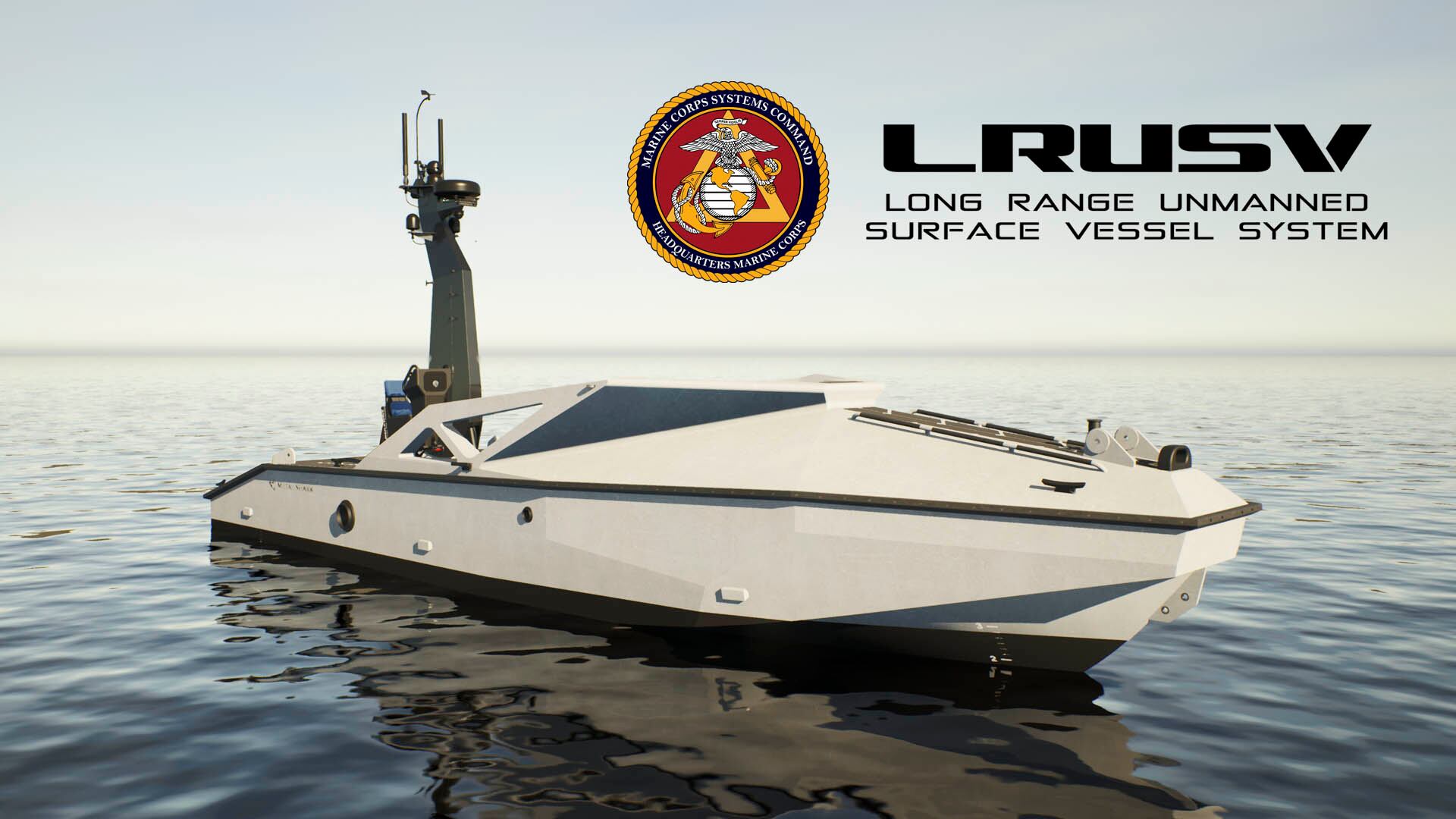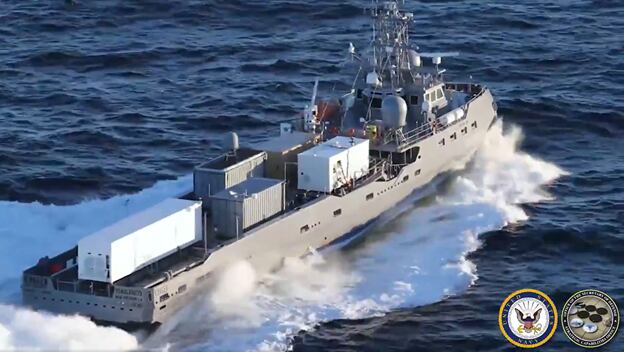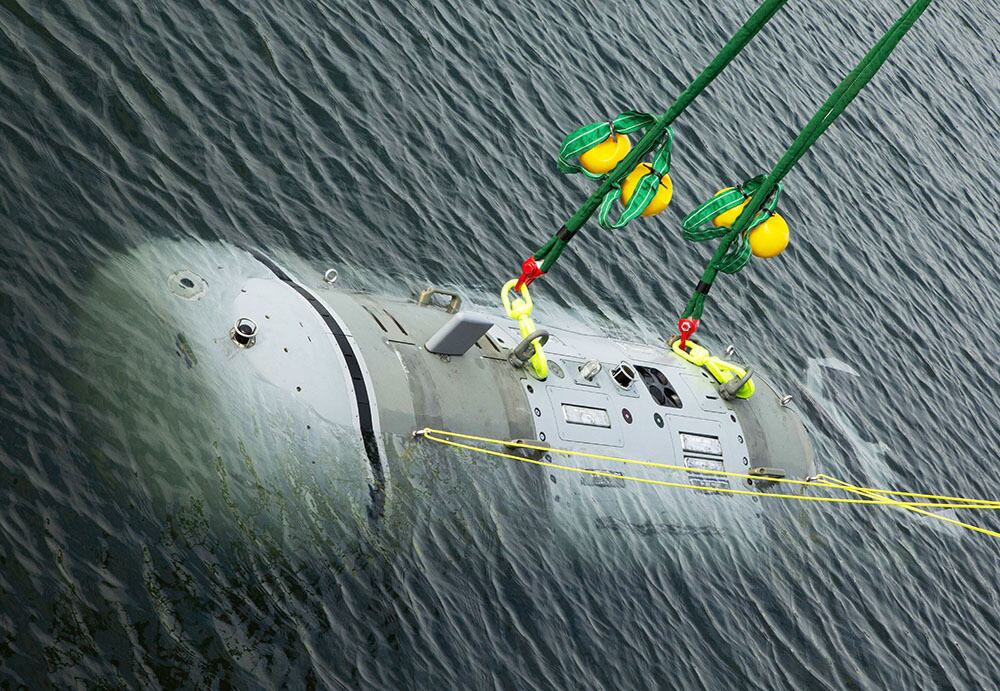WASHINGTON — The U.S. Navy and Marine Corps promised a “build a little, test a little, learn a lot” approach to unmanned vessels, and the lessons learned are already leading to some changes.
In the last month, the Navy has announced it is ditching its Large Displacement Unmanned Underwater Vehicle, raised questions about the future of the Medium Unmanned Surface Vehicle and stood up a new command for unmanned surface vessel fleet integration. The Marine Corps also recently accepted delivery of its own unmanned ship for experimentation that will inform future distributed operations.

Long-Range Unmanned Surface Vessel
As the Marine Corps prepares for a future that includes dispersed operations across a vast Indo-Pacific region, it’s turning to unmanned systems as an option for everything from passing data over long distances to resupplying far-flung Marines to finding and shooting at targets.
The service has already purchased unmanned aircraft, the MQ-9A, for aerial reconnaissance and communications-relay, but its first foray into unmanned boats could pack a more lethal punch.
In the first quarter of fiscal 2022, the Marines accepted the first of five Long-Range Unmanned Surface Vessel prototypes from Louisiana-based Metal Shark, Lt. Gen. Karsten Heckl, the deputy commandant for capabilities development and integration, told Defense News after a May 18 hearing.
Metal Shark in January 2021 announced it would develop for the Marine Corps “a network of unmanned vessels traveling autonomously for extended ranges and transporting loitering munitions to address targets at sea and on land.”
These unmanned boats will “accurately track and destroy targets at range throughout the battle space. While fully autonomous, the vessels may be optionally manned and they will carry multiple payloads, which they will be capable of autonomously launching and retrieving.”
Marine Corps leadership has said these vessels could also deliver supplies to Marines in remote locations, in addition to carrying offensive payloads.
Heckl told Defense News “the Marine Corps anticipates receiving additional prototypes in the third quarter of FY22 for continued testing and refinement. The Marine Corps remains on schedule and within budget to deliver an LRUSV Experimental Platoon to the Expeditionary Warfare Training Group - Atlantic for further development and unit training.

Medium Unmanned Surface Vehicle
U.S. 5th Fleet’s Task Force 59, whose mission is to apply unmanned and artificial intelligence prototype solutions to problems in the Middle East, has largely experimented with smaller unmanned systems that could be put in the water for rapid testing.
The results have the chief of naval operations rethinking the Navy’s plan to have a ship-sized Medium Unmanned Surface Vehicle in the fleet. Instead, cheaper and smaller waterborne drones could be fielded in significantly larger numbers to conduct the same mission: sensing the battlefield and providing situational awareness data back to the fleet.
“I don’t know if we’ll have a medium unmanned or not. The stuff that [5th Fleet Commander Vice Adm. Brad] Cooper’s doing right now with CTF-59 and using small unmanned on the sea, in the air to sense the environment and make sense of it in order to yield a common operational picture for allies and partners, as well as the Fifth Fleet headquarters, has changed my thinking on the direction of unmanned,” Adm. Mike Gilday said April 28 at an online event cohosted by the Center for Strategic and International Studies and the U.S. Naval Institute.
With lessons being learned so quickly through Task Force 59′s prototyping effort, “we may be able to close capability gaps with small, expendable unmanned off of any platform, rather than thinking that we have to build” a larger vessel. “I’m not saying that we don’t need an MSUV; I’m saying it will cause us to consider numbers and what potential payloads they’re going to have.”
Vice Adm. Scott Conn, the deputy chief of naval operations for warfighting requirements and capabilities, told Defense News after the May 18 hearing the path forward for a Large Unmanned Surface Vessel is clear, but the Navy needs to be thoughtful in its pursuit of a medium boat.
Conn said a classified study on the LUSV was recently completed. “That report references that the Large Unmanned Surface Vessel is probably the best choice from an adjunct magazine perspective, to force-multiple the number of munitions we have at sea,” he said.
As for MUSV, whose surveillance mission overlaps with smaller and cheaper options, “we need to take the time to get it right. The medium unmanned surface vessel: what sensors, what apertures we can put on that ship to be able to move the warfighting needle in a manner that contributes to the force.”
As the Navy considers how to best supplement its manned force to conduct distributed maritime operations in all domains, Conn said the Navy is working on enablers: conducting land-based testing of hull, mechanical and electrical systems to drive down risk ahead of putting unmanned boats in the water; developing and testing the software that underpins unmanned craft; drawing out specific use cases where unmanned and artificial intelligence tools could be useful; and then using the unmanned vessel prototypes already in the water to start testing against these use cases in fleet exercises to refine USV requirements and the Navy’s concepts for how to use them.

Large Displacement Unmanned Underwater Vehicle
Much like the MUSV, it’s unclear whether the Navy will pursue a large UUV or if its potential missions could be covered by the combination of larger and smaller UUVs in development.
The Navy proposed canceling the Snakehead LDUUV program in its fiscal 2023 budget request, released in April. According to budget documents, the UUV — planned to be employed by the submarine community, launching and recovering from attack submarines to help them see further and conduct other undersea warfare missions covertly — was not developed with the proper interfaces to work with the majority of the attack submarine fleet.
The LDUUV as it stands today can only interface with select submarines that have the Modernized Dry Deck Shelter and Payload Handling System, which “resulted in limited availability of host platforms to conduct Snakehead operations,” according to the budget document. “Cost and schedule delays associated with LDUUV development and Virginia Class [attack submarine] integration prohibited further investment.”
Asked whether the Navy needed another large-sized UUV properly designed with the right interfaces, or if it intended to abandon the pursuit of a large-sized UUV, Conn pointed to a program further along in development: the Orca Extra Large UUV.
The first XLUUV from Boeing is in the water, and the Navy will take custody of it in about a month, Conn said. XLUUV is a pier-launched vehicle that essentially acts as a mini submarine, conducting covert missions that could include laying mines or seabed sensors or looking for enemy submarines.
“We need to start experimenting, iterating and learning with that capability,” he said, with lessons learned from XLUUV potentially informing whether the Navy needs an additional sub-launched large UUV program.
Megan Eckstein is the naval warfare reporter at Defense News. She has covered military news since 2009, with a focus on U.S. Navy and Marine Corps operations, acquisition programs and budgets. She has reported from four geographic fleets and is happiest when she’s filing stories from a ship. Megan is a University of Maryland alumna.





